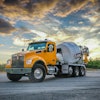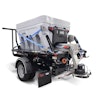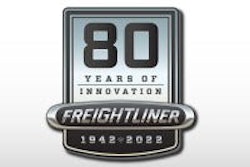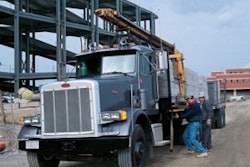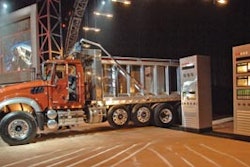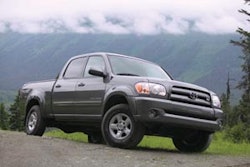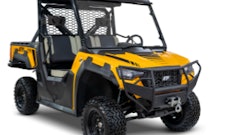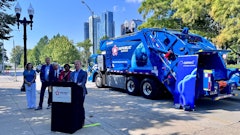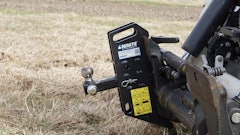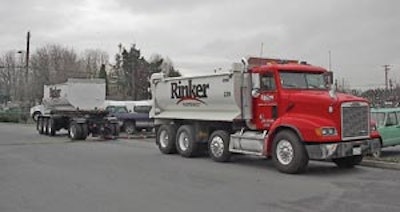
Vocational trucks have always been rather spartan, but many operations are realizing the value of upgrading trucks with creature comforts. With skilled drivers in short supply, a heavy emphasis is being placed on attracting veteran drivers and retaining current ones.
It can be hard to track a return on investment in upgraded features, but that doesn’t mean it doesn’t exist. Consider the cost of replacing a driver who leaves to work for someone with a newer and more highly spec’d truck fleet. “It is basically going to cost you in excess of $1,000 to hire a driver,” says Randy Goecke, maintenance manager, Rinker Materials.
Rinker runs a fleet of 58 dump trucks in the Portland region, and another 60 mixer trucks. These are primarily Freightliner FLD SD models. All of these trucks have been spec’d with operator comfort in mind. “If a driver is comfortable, he is going to fatigue slower,” says Goecke. “By reducing driver fatigue, they are much safer and more productive.”
Rinker has a particular interest in retaining its dump truck drivers. “About half of our trucks are transfers,” says Goecke. “A little over 25% of them are trucks and pups. A little less than 25% of them are belly dumps.” It takes a fairly skilled operator to drive a transfer dump. “Very seldom do you find one who is trained and has any sort of a background. We usually train them ourselves. We bring a driver in who has a lot of [general dump truck] experience and put them through a pretty extensive training program. We want to keep them, that is for sure.” To that end, the dump trucks are pretty much loaded with A/C, AM/FM and tilt and telescoping steering wheels.
Traditionally, the dump trucks were spec’d with more creature comforts than the mixer trucks due to the time spent in the cabs.
“The dump truck fleet will run an average of about 300 miles a day,” says Goecke. “A mixer, if they run 100 miles a day that’s a lot. There is a lot more windshield time in the cab as opposed to a mixer driver.” But recently, the emphasis on creature comforts has trickled into the mixer specs.
Now all of the trucks in the Rinker fleet are spec’d with air conditioning. A few years ago, this was unheard of. “It was an issue of saving weight and cost up front,” says Goecke. But now it is becoming more common. “It became another benefit to attract drivers to us vs. our competitors.”
Rinker even spent the money to convert its 1997 and 1998 models to A/C, despite the approximately $3,500 it cost for this option. “The reduction of fatigue dramatically improves safety and increases productivity,” Goecke says. “It is a major player in driver retention and being able to hire experienced drivers.”
In addition to cruise control and tilt and telescoping wheels, Rinker began spec’ing Allison automatic six-speed transmissions in mixer trucks two years ago. “The key issue was reducing driver fatigue,” says Goecke. But the automatic transmissions also increased productivity.
Rinker publishes a corporate spec guide for all of its divisions to follow. There are a few variations geographically, but the specs are very similar. “Image is big,” says Goecke. “We do spec a few cosmetic items. If it is a safety or comfort option, we look fairly hard at it. If it is a cosmetic-related option, we scrutinize that in a lot more depth.” All of these options help Rinker retain its drivers.
Drivers pick their own options
Catom Trucking, Geneva, IL, has been in business for 27 years. It offers a unique approach to spec’ing the Kenworth W900 long hood models used in its heavy-haul business. The basic drivetrain is spec’d by the company. “The last five had 625-hp Caterpillar engines,” says Tom Stellman, owner. In addition, they all feature the Eaton-Fuller clutch and Fuller Roadranger 18-speed transmission. “We have 46,000-lb. rear axles because we are a heavy hauler.” Two-speed rear ends allow a 3.70 ratio on the road and a 5.05 ratio off road. The exterior of the trucks are black and chrome.
The rest of the specs are determined by the drivers. “I was an owner/operator when I started out, so I know what it is like to be in the truck 10 hours a day,” says Stellman. “Comfort means a lot to the employees. I let them pick out all of their options.”
The result has been lower turnover. “I actually have people knocking on the door who have jobs with somebody else. They see our equipment out there in use and they want to come work for Catom Trucking,” says Stellman. “I get to pick from the cream of the crop.”
Catom Trucking recently acquired five Kenworth trucks and got rid of four. That leaves an extra seat to fill. Five people have already expressed an interest in the position. “They all have jobs right now and they are just waiting for the seat to open,” Stellman notes. “They have come in several times just to see if I am still interested.”
It takes a highly-developed skill set to become a successful heavy-haul driver. “Part of our responsibility is also safe loading and unloading. It takes a special person to do this kind of work,” says Todd Sauer, a nine-year veteran with Catom Trucking. “Your average guy cannot fit into this particular scenario. We are fortunate enough where we are able to pick and choose the employees a little closer than anybody else. Driver turnover is pretty nonexistent.”
Catom Trucking looks for drivers with a good amount of experience, and the trucks definitely help. “Our fleet is very recognizable,” says Sauer. “All of our equipment is black and a lot of chrome. The trailers are matched. If something looks like it needs painting, it goes to the paint shop.”
The image helps for recruiting in the field. “Since we are in the lowboy business, we are in and out of a lot of places where other lowboy truck drivers are on the site, loading or unloading,” says Stellman. “They get to compare their trucks to my trucks and there is really no comparison. Retail value is up there and I turn everything over every five years.”
How far does Stellman let the drivers go when spec’ing their trucks? “As far as the interiors go, there isn’t anything I have ever heard him say no to,” says Sauer. “I don’t know what else we could put into these things that we don’t have.”
Common choices include dual chrome air cleaners, color of the interior, extended cabs, sun roofs, cruise control, engine brakes, power windows, power door locks, air horns, marker lights and long sun visors. “The last group of guys all got black leather seats with the sun roof,” says Sellman. But individual choice allows customization.
“They get to pick an air-ride seat for the passenger side in case their wife or kids come along,” Stellman adds. Drivers even choose the exhaust configuration. “They get to pick if they want it behind the cab or outside the cab. Some people like the better view.”
The latest option to be added is wireless internet. This has proven valuable since permits can be e-mailed to the truck, and drivers can use the internet to make hotel reservations. It also has a mapping system. “The bottom line is we have to modernize,” says Stellman. “The whole system cuts downtime.”
These premium options do add to the initial purchase price of the trucks. “My truck was $160,800,” says Sauer. “They are all right around the $160,000 range.”
But the initial investment has paid off. “The trucks have performed every job required of them, and at the end of five years, I get a premium dollar because it is a very highly spec’d truck,” says Stellman.
“We have people calling our place all of the time looking for something that we have for sale,” says Sauer.
But one of the biggest benefits has been the driver loyalty this approach has fostered. “I am 43,” says Sauer. “I have been in construction or trucking my whole life and I have never quite seen a place like this.”
Drivers exhibit pride in their trucks. “My guys keep everything polished, from the fuel tanks to the wheels, because they are interactive,” says Stellman. “It is almost like they are an owner/operator. They are a company employee, but they treat their truck like their own. When I hire a driver I basically tell them that we are both here for the same reason — to make money. Let’s enjoy it. That’s what we do.”
A professional office
The 3M Company runs a fleet of 378 Peterbilt quad-axle dump trucks in Wausau, WI, to haul roofing grindings from a quarry to a coloring plant six miles away on the other side of town. These trucks run 24 hours a day, six days a week.
The trucks feature Peterbilt’s Prestige interior, which is very high end for the vocational market. They also have power windows, power locks, CD players, heated mirrors, sound packages, additional light packages, engine brakes and automatic transmissions.
“We went with a beige color to try to make them look nice because of the dust we have out there all of the time,” says Taylor Austin, general supervisor of the quarry, 3M Company. “We are seriously talking about painting the boxes to match because drivers take such pride in what they have.”
Austin explains the importance of spec’ing the premium features into the dump truck fleet. “I sit in an office all day long,” he says. “I have a phone, a nice chair and a great computer. I am very comfortable and we expect the same thing for our drivers.
They have to sit in that truck for an eight-hour shift. Twelve hours is not uncommon. We want them to be comfortable. We want them to be able to say that they have their own office.”
Automatic transmissions are one option that make life easier for the drivers. “In a typical day, drivers were pushing on a clutch 200 times a day,” says Austin. “Now they don’t have to push on it at all. In addition, 3M has seen an increase in fuel economy.
“The computers do the thinking for the drivers.” The transmissions also have better acceleration.
Admittedly, other companies may not be willing to spend the extra money on such premium features. “It just comes down to dollars and cents,” says Austin. “It really shouldn’t because your driver should come first. He is your point person. He is the one making you money.
“Our drivers are No. 1 and we want them to be comfortable, not beat up and abused,” Austin adds. “We want to make sure that we have maximized everything that we can for comfort. A happy driver is a happy employee.” The results speak for themselves. “We have 33 drivers and 80% are over 25 years [of employment]. We have next to no turnover. Basically, the only turnover we have is through retirement.”

